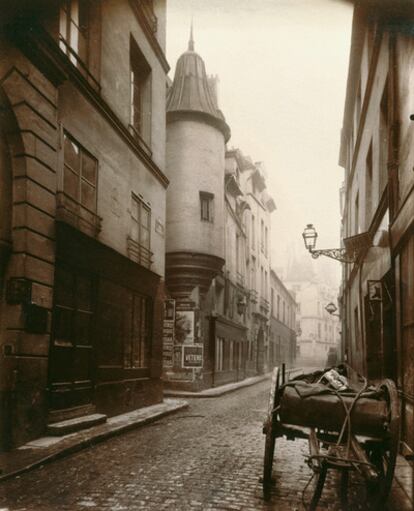An archive transformed into art
Eugène Atget's turn-of-the-century photos of Paris were used as models by painters, but now provide an insight into the city as it once was
Apart from constituting an unsurpassed esthetic experience, a stroll down the streets of Paris was elevated to poetic pinnacles by Baudelaire, that quintessential flanêur who made perambulation a form of artistic expression. And even though it has been said that in life, there's nothing like the original, there is in fact a substitute for the Paris stroll: opening a book filled with Eugène Atget's turn-of-the-century photographs. Or better yet, visiting the Mapfre Foundation in Madrid and taking in a show that features more than 200 works by one of the great pioneers of documentary photography.
Atget was not part of the Paris art world; in fact he was completely anonymous to everyone outside his immediate circle of family and friends. That is why he would never have dreamed of one day seeing part of his extensive oeuvre hanging inside museums. But the show Eugène Atget. El viejo París (The Old Paris), featuring a selection of photographs culled from a 4,000-strong archive and loaned by the Musée Carnavalet in Paris and the George Eastmann House in Rochester (New York), paints an emotional and unsettling picture of the City of Lights... even though Atget's Paris does not exactly blow viewers away with its sheen. Instead, his sepia shots capture the city in the late 19th and early 20th centuries through its door knockers, elegant staircases, alleyways lit with oil lamps, little squares, bed-and-breakfasts with no stars to recommend them, fruit-and-vegetable stands, and prostitutes leaning against the call houses.
Carlos Gollonet, the Spanish curator of the show ? which will travel to Rotterdam, Paris and Sydney after stopping in Madrid ? explains that the settings and the people portrayed time and again by Atget "together make up a genuine Comédie humaine in the best Balzac style."
This kind of naturalism had its roots in the personal circumstances of Eugène Atget, who never trained as a photographer, and ended up doing this after trying his hand at various other trades. Atget never demonstrated any creative impulses. Instead, he was considered a commercial photographer, who sold what he described as "documents for artists" ? that is to say, landscapes, close-ups, genre scenes and other shots that served as models for painters.
Despite the modesty of his ambitions, when Atget trained his camera on the streets of Paris, institutions such as the Musée Carnavelet and the National Library sat up and took notice. Eventually, they became his main clients. Atget's eye strayed away from the stereotypical Belle Epoque scenes, and his shots show no trace of can-can dancing, of Sundays in the park, or of absinthe bottles sitting on tables. Instead, he preferred to shoot deserted streets. Using his bellows camera and tripod, he would take shot after shot of his chosen subject matter. Spurred on by a scientific mindset, he catalogued and classified all of his material and took it to the artist studios, where people like Georges Braque and Pablo Picasso were assiduous clients of his.
They were not the only ones. The avant-garde movements, especially Surrealism, saluted his work with the kind of enthusiasm reserved for a colleague. The fact that Man Ray was his neighbor and acquaintance surely played a role. The artist collected dozens of those Atget shots, and some are included in a section of the exhibition together with the green-sleeved album that held them for many years.
Man Ray did something else for the errant photographer. Together with fellow snapper Berenice Abbot, he worked to raise Atget's work to museum category. The determination he put into it was not unlike Baudelaire's own drive to dignify something as simple as a stroll.
Eugène Atget. El viejo parís 1898-1924. Until August 27 at Fundación Mapfre, Madrid. See www.exposicionesmapfrearte.com/eugeneatget for more information.

Tu suscripción se está usando en otro dispositivo
¿Quieres añadir otro usuario a tu suscripción?
Si continúas leyendo en este dispositivo, no se podrá leer en el otro.
FlechaTu suscripción se está usando en otro dispositivo y solo puedes acceder a EL PAÍS desde un dispositivo a la vez.
Si quieres compartir tu cuenta, cambia tu suscripción a la modalidad Premium, así podrás añadir otro usuario. Cada uno accederá con su propia cuenta de email, lo que os permitirá personalizar vuestra experiencia en EL PAÍS.
¿Tienes una suscripción de empresa? Accede aquí para contratar más cuentas.
En el caso de no saber quién está usando tu cuenta, te recomendamos cambiar tu contraseña aquí.
Si decides continuar compartiendo tu cuenta, este mensaje se mostrará en tu dispositivo y en el de la otra persona que está usando tu cuenta de forma indefinida, afectando a tu experiencia de lectura. Puedes consultar aquí los términos y condiciones de la suscripción digital.
Últimas noticias
The brief rise and retreat of Generation Z in Mexico
From safe-haven investment to geostrategic weapon: Who owns the most gold and where are the bars kept?
Todd Green, head of the company that created ‘Candy Crush’: ‘Success for us is that players want to play for years’
Prices soar and Venezuela’s economy struggles under Trump’s pressure: ‘People are living day to day’
Most viewed
- Why we lost the habit of sleeping in two segments and how that changed our sense of time
- Trump’s obsession with putting his name on everything is unprecedented in the United States
- Charles Dubouloz, mountaineering star, retires at 36 with a farewell tour inspired by Walter Bonatti
- Venezuela faces its most tense Christmas yet
- The Florida Keys tourist paradise is besieged by immigration agents: ‘We’ve never seen anything like this’








































